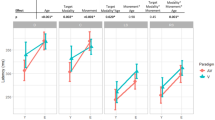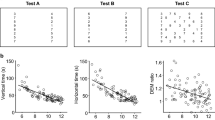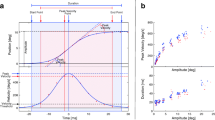Abstract
In real life we produce vertical saccades at different distances and eccentricities, and while our fixation is more or less actively engaged. The goal of this study is to examine vertical saccades in aged and young subjects, taking into consideration all these parameters. Eleven adults (20–28 years) and 11 aged subjects (63–83 years) were recruited. We used LED targets at 7.5° or 15°, up or down in four conditions: gap and overlap tasks, each done at two distances—at near (40 cm) and at far (150 cm). In the gap task fixation target extinguishes prior to target onset, while in the overlap condition it stays on after target onset; consequently, visual attention and fixation are employed differently in the two tasks. Eye movements were recorded with the Chronos video eye tracker. Results showed that vertical saccades were longer for aged subjects than for young adults under almost all conditions. For both aged and young subjects, latencies were shorter under the gap than under the overlap task. Latencies for eccentric targets at 15° were significantly longer than those at 7.5° but for aged subjects only; this effect was more pronounced for upward saccades under the overlap condition. Express type of latencies (80–120 ms) occurred frequently in the gap task and at similar rates for young adults (16%) and aged subjects (12%); in the overlap task express latencies were scarce in young adults (0.4%) and aged subjects (1.8%). Age deteriorates the ability to trigger regular volitional saccades but not the ability to produce express type of saccades. Latency increase with aging is attributed to the degeneration of central areas, e.g. oculomotor cortical areas involved in the initiation of vertical saccades.







Similar content being viewed by others
References
Abel LA, Troost BT, Dell’Osso LF (1983) The effects of age on normal saccadic characteristics and their variability. Vis Res 23:33–37
Baizer JS, Bender DB (1989) Comparison of saccadic eye movements in humans and macaques to single-step and double-step target movements. Vis Res 29:485–495
Becker W (1989) The neurobiology of saccadic eye movements. Metrics. Rev Oculomot Res 3:13–67
Bell AH, Everling S, Munoz DP (2000) Influence of stimulus eccentricity and direction on characteristics of pro- and antisaccades in non-human primates. J Neurophysiol 84:2595–2604
Biscaldi M, Fischer B, Aiple F (1994) Saccadic eye movements of dyslexic and normal reading children. Perception 23:45–64
Biscaldi M, Fischer B, Stuhr V (1996) Human express saccade makers are impaired at suppressing visually evoked saccades. J Neurophysiol 76:199–214
van den Bosch WA, Leenders I, Mulder P (1999) Topographic anatomy of the eyelids, and the effects of sex and age. Br J Ophthalmol 83:347–352
Bucci MP, Kapoula Z, Yang Q, Wiener-Vacher S, Bremond-Gignac D (2004) Abnormality of vergence latency in children with vertigo. J Neurol 251:204–213
Bucci MP, Pouvreau N, Yang Q, Kapoula Z (2005) Influence of gap and overlap paradigms on saccade latencies and vergence eye movements in seven-year-old children. Exp Brain Res 164:48–57
Carter JE, Obler L, Woodward S, Albert ML (1983) The effect of increasing age on the latency for saccadic eye movements. J Gerontol 38:318–320
Chan F, Armstrong IT, Pari G, Riopelle RJ, Munoz DP (2005) Deficits in saccadic eye-movement control in Parkinson’s disease. Neuropsychologia 43:784–796
Clarke AH, Ditterich J, Druen K, Schonfeld U, Steineke C (2002) Using high frame rate CMOS sensors for three-dimensional eye tracking. Behav Res Methods Instrum Comput 34:549–560
Coubard O, Daunys G, Kapoula Z (2004) Gap effects on saccade and vergence latency. Exp Brain Res 154:368–381
Creasey H, Rapoport SI (1985) The aging human brain. Ann Neurol 17:2–10
Findlay JM, Walker R (1999) A model of saccade generation based on parallel processing and competitive inhibition discussion (674–721). Behav Brain Sci 22:661–674
Fischer B, Biscaldi M, Gezeck S (1997a) On the development of voluntary and reflexive components in human saccade generation. Brain Res 754:285–297
Fischer B, Gezeck S, Hartnegg K (1997b) The analysis of saccadic eye movements from gap and overlap paradigms. Brain Res Brain Res Protoc 2:47–52
Fischer B, Weber H (1990) Saccadic reaction times of dyslexic and age-matched normal subjects. Perception 19:805–818
Fischer B, Weber H (1993) Express saccades and visual attention. Behav Brain Res 57:191–195
Fuller JH (1996) Eye position and target amplitude effects on human visual saccadic latencies. Exp Brain Res 109:457–466
Gezeck S, Fischer B, Timmer J (1997) Saccadic reaction times: a statistical analysis of multimodal distributions. Vision Res 37:2119–2131
Goldring J, Fischer B (1997) Reaction times of vertical prosaccades and antisaccades in gap and overlap tasks. Exp Brain Res 113:88–103
Haas A, Flammer J, Schneider U (1986) Influence of age on the visual fields of normal subjects. Am J Ophthalmol 101:199–203
Hackman R (1940) An experimental study of the variability in ocular latency. J Exp Psychol 27:546–558
Head D, Buckner RL, Shimony JS, Williams LE, Akbudak E, Conturo TE, McAvoy M, Morris JC, Snyder AZ (2004) Differential vulnerability of anterior white matter in nondemented aging with minimal acceleration in dementia of the Alzheimer type: evidence from diffusion tensor imaging. Cereb Cortex 14:410–423
Heywood S, Churcher J (1980) Structure of the visual array and saccadic latency: implications for oculomotor control. Q J Exp Psychol 32:335–341
Honda H, Findlay JM (1992) Saccades to targets in three-dimensional space: dependence of saccadic latency on target location. Percept Psychophys 52:167–174
Huaman AG, Sharpe JA (1993) Vertical saccades in senescence. Invest Ophthalmol Vis Sci 34:2588–2595
Kingstone A, Klein RM (1993) Visual offsets facilitate saccadic latency: does predisengagement of visuospatial attention mediate this gap effect? J Exp Psychol Hum Percept Perform 19:1251–1265
Klein C, Fischer B, Hartnegg K, Heiss WH, Roth M (2000a) Optomotor and neuropsychological performance in old age. Exp Brain Res 135:141–154
Klein CH, Brugner G, Foerster F, Muller W, Schweickhardt A (2000b) The gap effect in pro-saccades and anti-saccades in psychometric schizotypes. Biol Psychol 55:25–39
Luna B, Sweeney JA (2001) Studies of brain and cognitive maturation through childhood and adolescence: a strategy for testing neurodevelopmental hypotheses. Schizophr Bull 27:443–455
Miles LK (1936) The reaction time of the eye. Psychol Monogr 47:268–293
Miller LK (1969) Eye-movement latency as a function of age, stimulus uncertainty, and position in the visual field. Percept Mot Skills 28:631–636
Munoz DP, Broughton JR, Goldring JE, Armstrong IT (1998) Age-related performance of human subjects on saccadic eye movement tasks. Exp Brain Res 121:391–400
Munoz DP, Corneil BD (1995) Evidence for interactions between target selection and visual fixation for saccade generation in humans. Exp Brain Res 103:168–173
Owsley C, Burton-Danner K, Jackson GR (2000) Aging and spatial localization during feature search. Gerontology 46:300–305
Pierrot-Deseilligny C, Muri RM, Rivaud-Pechoux S, Gaymard B, Ploner CJ (2002) Cortical control of spatial memory in humans: the visuooculomotor model. Ann Neurol 52:10–19
Pierrot-Deseilligny C, Rivaud S, Gaymard B, Muri R, Vermersch AI (1995) Cortical control of saccades. Ann Neurol 37:557–567
Pratt J, Abrams RA, Chasteen AL (1997) Initiation and inhibition of saccadic eye movements in younger and older adults: an analysis of the gap effect. J Gerontol B Psychol Sci Soc Sci 52:P103–P107
Reuter-Lorenz PA, Hughes HC, Fendrich R (1991) The reduction of saccadic latency by prior offset of the fixation point: an analysis of the gap effect. Percept Psychophys 49:167–175
Rivaud S, Muri RM, Gaymard B, Vermersch AI, Pierrot-Deseilligny C (1994) Eye movement disorders after frontal eye field lesions in humans. Exp Brain Res 102:110–120
Ross LE, Ross SM (1980) Saccade latency and warning signals: stimulus onset, offset, and change as warning events. Percept Psychophys 27:251–257
Ross SM, Ross LE (1981) Saccade latency and warning signals: effects of auditory and visual stimulus onset and offset. Percept Psychophys 29:429–437
Salat DH, Kaye JA, Janowsky JS (2001) Selective preservation and degeneration within the prefrontal cortex in aging and Alzheimer disease. Arch Neurol 58:1403–1408
Sano N, Adachi-Usami E (1990) Aging effects on upper and lower half visual fields by VECPs and automated static perimetry. Nippon Ganka Gakkai Zasshi 94:527–531
Saslow MG (1967) Effects of components of displacement-step stimuli upon latency for saccadic eye movement. J Opt Soc Am 57:1024–1029
Schiller PH, Sandell JH, Maunsell JH (1987) The effect of frontal eye field and superior colliculus lesions on saccadic latencies in the rhesus monkey. J Neurophysiol 57:1033–1049
Tzelepi A, Yang Q, Kapoula Z (2005) The effect of transcranial magnetic stimulation on the latencies of vertical saccades. Exp Brain Res 164:67–77
Weber H, Fischer B (1995) Gap duration and location of attention focus modulate the occurrence of left/right asymmetries in the saccadic reaction times of human subjects. Vis Res 35:987–998
Wenban-Smith MG, Findlay JM (1991) Express saccades: is there a separate population in humans? Exp Brain Res 87:218–222
Yang Q, Bucci MP, Kapoula Z (2002) The latency of saccades, vergence, and combined eye movements in children and in adults. Invest Ophthalmol Vis Sci 43:2939–2949
Yang Q, Kapoula Z, Debay E, Coubard O, Orssaud C, Samson M (2005) Prolongation of latency of horizontal saccades in elderly is distance and task specific. Vis Res (in press)
Zhou W, King WM (2002) Attentional sensitivity and asymmetries of vertical saccade generation in monkey. Vis Res 42:771–779
Acknowledgement
Q. Yang was supported by European Union (QLK6-CT-2002-00151: EUROKINESIS) and CNRS/CTI, Handicap contract. L. Ferrufino performed part of the recordings (DEA diploma, university of Paris V, 2004); D Evelyne Golomer (sports medicine) recruited the aged subjects. The authors thank G. Daunys for programming and electronic help; M. Ehrette for mechanics of the visual display.
Author information
Authors and Affiliations
Corresponding author
Additional information
Grant/financial support: European Union (QLK6-CT-2002-00151: EUROKINESIS) and CNRS/CTI, Handicap contract CR:N.
Rights and permissions
About this article
Cite this article
Yang, Q., Kapoula, Z. The control of vertical saccades in aged subjects. Exp Brain Res 171, 67–77 (2006). https://doi.org/10.1007/s00221-005-0249-x
Received:
Accepted:
Published:
Issue Date:
DOI: https://doi.org/10.1007/s00221-005-0249-x




